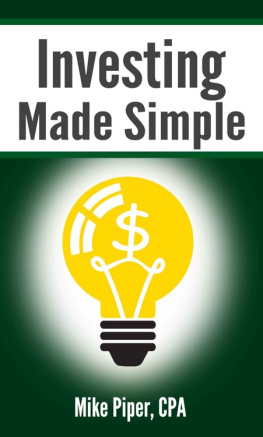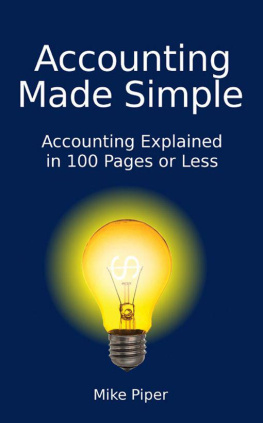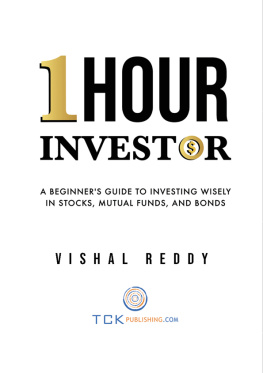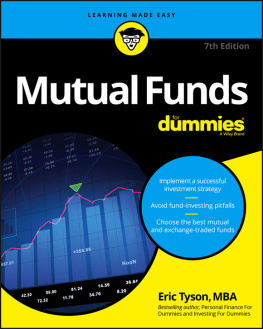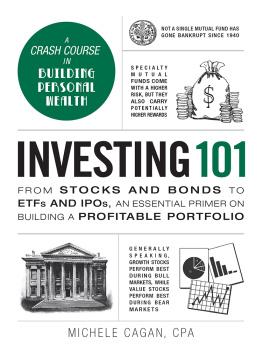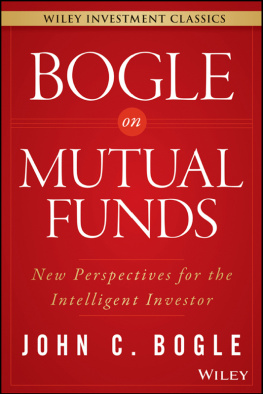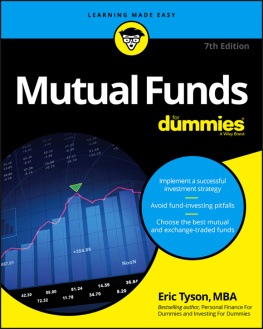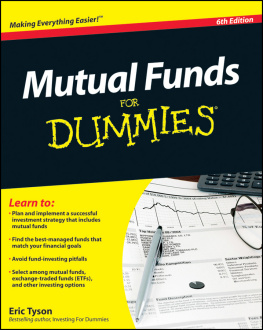Investing Made Simple
Investing in Index Funds
Explained in 100 Pages or Less
Why is there a light bulb on the cover?
In cartoons and comics, a light bulb is often used to signify a moment of clarity or sudden understandingan aha! moment. My hope is that the books in the in 100 pages or less series can help readers achieve clarity and understanding of topics that are often considered complex and confusinghence the light bulb.
Copyright 2015 Simple Subjects, LLC
No part of this publication may be reproduced or distributed without express permission of the publisher.
ISBN: 978-0-9814542-4-5
www.ObliviousInvestor.com
Investing Made Simple
Investing in Index Funds
Explained in 100 Pages or Less
Mike Piper, CPA
A note on the data used:
Except when stated otherwise, bond returns are calculated using the Intermediate-Term Government Bonds data series (which tracks the return of 5-year Treasury bonds) from the Ibbotson SBBI 2014 Classic Yearbook, published by Morningstar. Stock market returns are calculated using the Large Company Stocks data series (which currently tracks the S&P 500) from the Ibbotson SBBI 2014 Classic Yearbook.
Disclaimer:
This book is not intended to be a substitute for personalized advice from a professional financial planner. Nothing contained within this text should be construed as financial advice. The publisher and author make no representation or warranty as to this books adequacy or appropriateness for any purpose. Similarly, no representation or warranty is made as to the accuracy of the material in this book.
Purchasing this book does not create any client relationship or other advisory, fiduciary, or professional services relationship with the publisher or with the author. You alone bear the sole responsibility of assessing the merits and risks associated with any financial decisions you make. And it should always be kept in mind that any investment can result in partial or complete loss.
Dedication
To you, the reader, for taking the initiative to take charge of your finances.
Your Feedback is Appreciated!
As the author of this book, Im very interested to hear your thoughts. If you find the book helpful, please let me know! Alternatively, if you have any suggestions of ways to make the book better, Im eager to hear that, too.
Finally, if youre dissatisfied with your purchase for any reason, let me know, and Ill be happy to provide you with a refund of the current list price of the book (limited to one refund per household).
You can reach me at: .
Best Regards,
Mike Piper, CPA
Table of Contents
Part One:
The Basics
Part Two:
Constructing a Portfolio
Part Three:
Stay out of Trouble
INTRODUCTION
Investing isNotComplicated.
Many people seem to think that investing is a complicated, highly technical topic. Its really not. Or at least, it doesnt have to be. In fact, Im confident that the majority of what you need to know about investing can be explained in just 100 pages. No need for a big, thick textbook. No need for an advanced degree in finance.
Of course, theres an entire industry built upon convincing us that investing is complicated. But well get to that later.
For now, just know that investing is something youre capable of understanding on your own. And, if youve found investing to be confusing in the past, its probably due (at least in part) to the fact that youve been bombarded with a bunch of conflicting information from parties who are each more concerned with getting you to consume their products and services than they are with providing you with unbiased advice.
For example, the discount brokerage firms would have you believe that the path to investment success is to pick stocks (and to trade them frequently). The mutual fund industry, on the other hand, would make the case that youre better off having a professional pick the stocks for you. Whom should you believe?
Is This the Right Book for You?
To be entirely up front: Given its short length, this book is not going to turn you into an investing guru. And its certainly not going to provide you with any sort of way to get rich overnight. Thats not its goal. Its goal is simply to provide you with enough information to either:
- Get started investing for your future, or
- If youve already begun to invest, to take a look at your current strategy to see whether it could use any changes.
My hope is that youll supplement the information you gain from this book with either:
- The services of a trustworthy, well-informed financial advisorin Chapter 12 we discuss some tips for finding such a personor
- An ongoing program of self-education, should you decide to handle your investments on your own. (Several suggestions for further reading are provided in the appendix.)
With that out of the way, lets get started, shall we?
PART ONE
Investing Basics
CHAPTER ONE
The Building Blocks
Before we can have any meaningful discussion about investing, we need to define the most basic building blocks of an investment portfolio: stocks, bonds, and mutual funds. Well talk more in later chapters about the advantages and disadvantages of each of these investmentsas well as how to determine how much of your portfolio to allocate to each. For now, lets just make sure were up to speed on definitions.
Stocks
A stock (sometimes referred to as an equity) is a piece of ownership in a company. The value of a stock lies in the fact that companies (usually) earn profits. Those profits are either:
| a) | Distributed to the shareholders (in a payment known as a dividend), or |
| b) | Reinvested to grow the company (thereby hopefully increasing the value of the company and, eventually, the share price). |
Bonds
A bond is a loan made by an investor to a company, a government, or a governmental agency. The value of a bond lies in the fact that the borrower agrees to pay interest to the lender.
Mutual Funds
A mutual fund is simply a collection of stocks, bonds, or other investments that has been chosen by a professional investor (known as a fund manager). Most mutual funds are known as actively managed funds because their fund managers are actively searching for investments that they believe will earn above-average returns.
Index Funds
Some mutual funds, however, are not actively managed, but passively managed. These fundsknown as index fundsare designed to simply mimic the performance of a given index.
Whats an index? In the field of investing, indexes are indicators that represent the value of a particular group of investments. For example, the S&P 500 is an index that tracks the performance of 500 of the largest companies in the United States. Therefore, an S&P 500 index fund is a mutual fund that owns shares of each of the companies in the S&P 500 and which should closely mimic the performance of the S&P 500 index.
There are indexes that track just about everything you could imagine, and more indexes (and index funds) are being created every year. Fortunately, you only need to know about a handful of different index funds in order to create a diversified portfolio.

